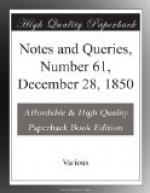Rich in all the bibliopolic “pearl and gold” of a quaint and fanciful binding, glancing with holly berries and mistletoe, Mr. Bogue presents us with a volume as interesting as it is characteristic and elegant, Christmas with the Poets. A more elegantly printed book was never produced; and it is illustrated with fifty engravings designed and drawn on wood by Birket Foster; engraved by Henry Vizetelly, and printed in tints in a way to render most effective the artist’s tasteful, characteristic, and very able drawings. The volume is, as it were, a casket, in which are enshrined all the gems which could be dug out of the rich mines of English poetry; and when we say that the first division treats of Carols from the Anglo-Norman period to the time of the Reformation; that these are followed by Christmas Poems of the Elizabethan period, by Shakspeare, Ben Jonson, and their great cotemporaries; that to these succeed Herrick’s Poems, and so on, till we have the Christmas verses of our own century, by Southey, Wordsworth, Scott, Shelley, Tennyson, &c., we have done more than all our praise could do, to prove that a fitter present to one who loves poetry could not be found than Christmas with the Poets.
While if it be a little lover of poetry—mind, not one who little loves poetry, but one who listens with delight to those beloved ditties of the olden times, which as we know charmed Shakspeare’s childhood,—learn that an English lady, with the hand and taste of an artist, guided and refined by that purest and holiest of feelings, a mother’s love, has illustrated those dear old songs in a way to delight all children; and at the same time charm the most refined. The Illustrated Ditties of the Olden Time is in sooth a delightful volume, and if a love of the beautiful be as closely connected with a love of the moral as wise heads tell us, we know no more agreeable way of early inculcating morality than by circulating this splendid edition of our time-honoured Nursery Rhymes.
But we fancy the taste of some of our readers may not yet have been hit upon. Let them try The Story of Jack and the Giants, illustrated by Richard Doyle; and {524} they will find this wondrous story rendered still more attractive by some thirty drawings, from the pencil of one of the most imaginative artists of the day, and whose artistic spirit seems to have revelled with delight as he pourtrayed the heroic achievements of “the valiant Cornish man.”
We will now turn to those works which are of a somewhat graver class; and we will begin with Miss Drury’s able and well-written story, entitled Eastbury, in which the heavy trials of Beatrice Eustace, mitigated and eventually overcome through the friendship and truthfulness of Julia Seymour, are told in a manner to delight all readers of the class of tales to which Eastbury belongs; and to sustain the reputation as a writer, which Miss Drury so deservedly acquired by her former story, Friends and Fortune.




